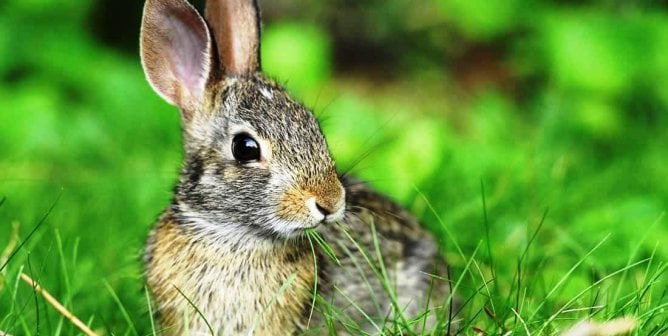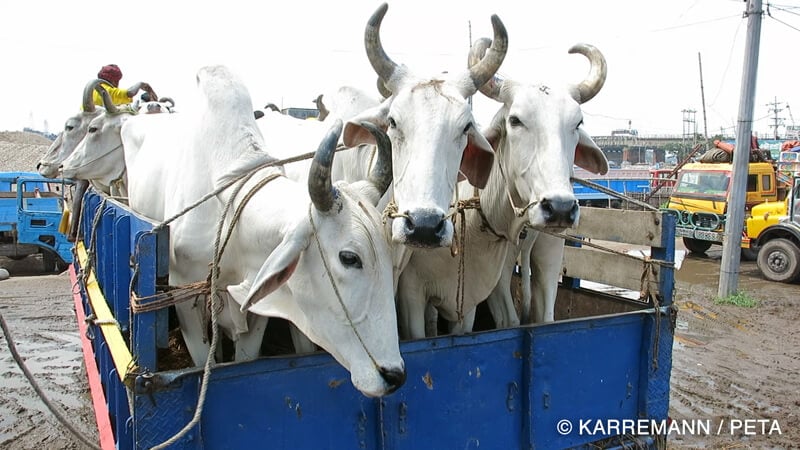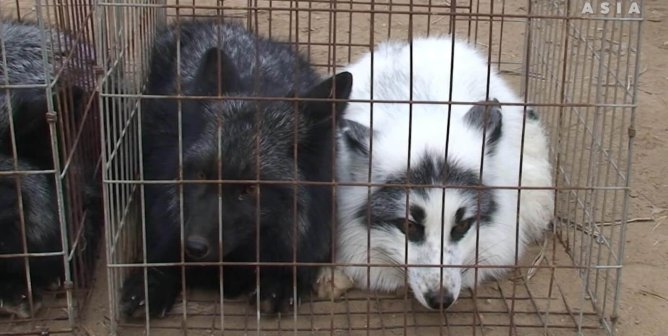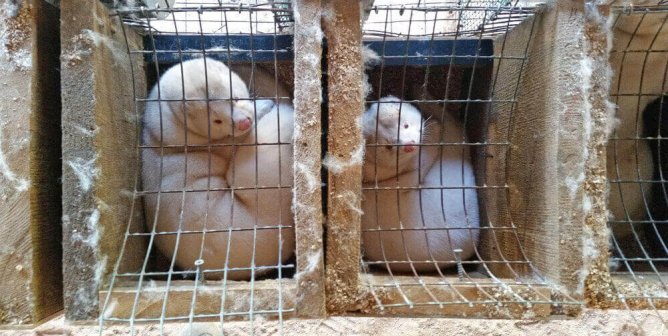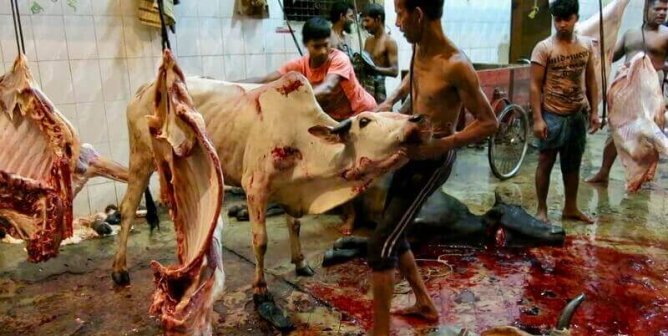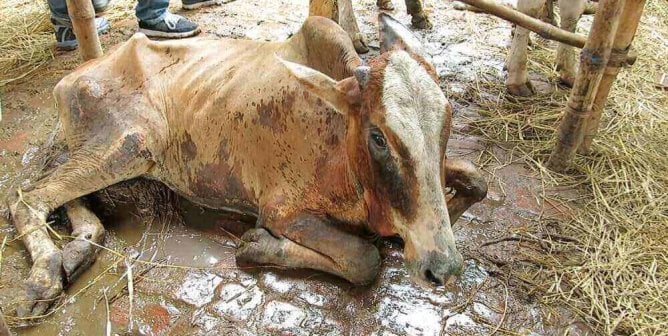Inside the Fur Industry: Factory Farms
About 85 percent of the fur industry’s skins come from animals living captive in fur factory farms.1 These farms can hold thousands of animals, and their farming practices are remarkably uniform around the globe. As with other intensive-confinement animal farms, the methods used in fur factory farms are designed to maximize profits, always at the expense of the animals.
Painful and Short Lives
The most commonly farmed fur-bearing animals are minks, followed by foxes. Chinchillas, lynxes and raccoon dogs are also farmed for their fur.2 A PETA exposé of Russian facilities where animals are bred and slaughtered for their fur revealed one operation where 700 cages imprisoned 2,000 animals in just a single shed. At other facilities, workers didn’t bother to verify that animals were unconscious before severing their heads or breaking their necks. For more on this investigation, please see PETA.org.
Fifty percent of mink farms are in Europe, and the rest are dispersed throughout the world, in North America and countries such as Argentina, China, and Russia.3 At facilities where minks are bred and slaughtered for fur, workers usually breed female minks once a year. There are about three or four surviving kittens in each litter, and they are killed when they are about 6 months old, depending on what country they are in, after the first hard freeze. Minks used for breeding are kept for four to five years.4 The animals—who are housed in unbearably small cages—live with fear, stress, disease, parasites, and other physical and psychological hardships, all for the sake of an unnecessary global industry that makes billions of dollars annually. For more on what happens to these animals, see this PETA exposé of a U.S. mink farm.
Rabbits are slaughtered by the millions for meat, particularly in China, Italy, and Spain. Once considered a mere byproduct of this consumption, the rabbit-fur industry demands the thicker pelt of an older animal (rabbits raised for meat are killed before the age of 12 weeks).5 The United Nations reports that at least 1 billion rabbits are killed each year for their fur, which is used in clothing, as lures in flyfishing, and for trim on craft items.6 A PETA Asia investigation of rabbit fur farms and a slaughterhouse in China found rabbits forced to live in cramped, filthy cages before finally being strung up and skinned—sometimes while still alive.
Life on the ‘Ranch’
To cut costs, fur farmers pack animals into small cages, preventing them from taking more than a few steps back and forth. This crowding and confinement is especially distressing to minks—solitary animals who may occupy up to 2,500 acres of wetland habitat in the wild.7 The anguish and frustration of life in a cage leads minks to self-mutilate—biting at their skin, tails, and feet—and frantically pace and circle endlessly. Zoologists at Oxford University who studied captive minks found that despite generations of being bred for fur, minks have not been domesticated and suffer greatly in captivity, especially if they are not given the opportunity to swim.8 Foxes, raccoons, and other animals suffer just as much and have been found to cannibalize their cagemates in response to their crowded confinement.
Animals in fur factory farms are fed meat byproducts considered unfit for human consumption. Water is provided by a nipple system, which often freezes in the winter or might fail because of human error.
Poison and Pain
No federal humane slaughter law protects animals in fur factory farms, and killing methods are gruesome. Because fur farmers care only about preserving the quality of the fur, they use slaughter methods that keep the pelts intact but that can result in extreme suffering for the animals. Small animals may be crammed into boxes and poisoned with hot, unfiltered engine exhaust from a truck. Engine exhaust is not always lethal, and some animals wake up while they are being skinned. Larger animals have clamps attached to or rods forced into their mouths and rods are forced into their anuses, and they are painfully electrocuted. Other animals are poisoned with strychnine, which suffocates them by paralyzing their muscles with painful, rigid cramps. Gassing, decompression chambers, and neck-breaking are other common slaughter methods on fur factory farms. For more on the suffering these animals endure before death, see this PETA investigation of a Wisconsin fur farm.
The fur industry refuses to condemn even blatantly cruel killing methods such as electrocution. According to the American Veterinary Medical Association, electrocution causes “death by cardiac fibrillation, which causes cerebral hypoxia,” but warns that “animals do not lose consciousness for 10 to 30 seconds or more after onset of cardiac fibrillation.” In other words, the animals are forced to suffer from a heart attack while they are still conscious.9
Would You Wear Your Dog?
When PETA conducted an undercover investigation into the dog and cat fur trade in 2005, investigators went to an animal market in Southern China and found that dogs and cats were languishing in tiny cages, visibly exhausted. Some had been on the road for days, transported in flimsy wire-mesh cages with no food or water. Animals were packed so tightly into cages that they could not move. Because of the cross-country transport in such deplorable conditions, our investigators saw dead cats on top of the cages, dying cats and dogs inside the cages, and cats and dogs with open wounds. Some animals were lethargic, and others were fighting with each other, driven insane from confinement and exposure. All of them were terrified.
Investigators reported that up to 800 animals were loaded onto each truck, with cages stacked on top of each other. Cages containing live animals were tossed from the tops of the trucks onto the ground 10 feet below, shattering the legs of the animals inside them. Many of the animals still had collars on, a sign that they were once someone’s beloved companions, stolen to be bludgeoned, hanged, bled to death, and strangled with wire nooses so that their fur can be turned into coats, trim, and trinkets.
Undercover investigators from Swiss Animal Protection/EAST International toured fur farms in China’s Hebei Province and found that foxes, minks, rabbits, and other animals were pacing and shivering in outdoor wire cages, exposed to everything from scorching sun to freezing temperatures to driving rain. Disease and injuries are widespread on these farms, and animals suffering from anxiety-induced psychosis chew on their own limbs and repeatedly throw themselves against the cage bars.
The globalization of the fur trade has made it impossible to know where fur products come from. Skins move through international auction houses and are purchased and distributed to manufacturers around the world, and finished goods are often exported. Even if a fur garment’s label says that it was made in a European country, the animals were likely raised and slaughtered elsewhere—possibly on a Chinese fur farm, where there are no penalties for abusing animals.
Health Risks and Environmental Destruction
Pathogens flourish on fur farms as well as in live-animal markets, so when it comes to the public health risks that they pose, these environments are no different. Deadly diseases can spread to humans in places where animals are kept in close confinement or killed. Cramming animals together in filthy conditions caused the novel coronavirus pandemic, and it has also caused mutations. According to the World Health Organization, as of late 2020, “Six countries, namely Denmark, the Netherlands, Spain, Sweden, Italy and the United States of America have reported SARS-CoV-2 in farmed minks.”10 Human cases of COVID-19 were identified in Denmark with SARS-CoV-2 variants associated with farmed minks, including a dozen cases with a unique variant.11 Denmark has since announced plans to kill millions of minks who have already been bred on its farms in an attempt to curb the spread of the mutated virus—one that could have “devastating consequences worldwide,” according to Mette Frederiksen, the country’s prime minister.12
Contrary to fur-industry propaganda, fur production destroys the environment. The amount of energy needed to produce a real fur coat from ranch-raised animal skins is approximately 20 times that needed to produce a fake fur garment.13 Nor is fur biodegradable, thanks to the chemical treatment applied to stop the fur from rotting. The process of using these chemicals is also dangerous because it can cause water contamination. Each mink skinned by fur farmers produces about 44 pounds of feces.14 Based on the total number of minks skinned in the U.S. in 2014, which was 3.76 million, mink factory farms generate tens of thousands of tons of manure annually.15 One result is nearly 1,000 tons of phosphorus, which wreaks havoc on water ecosystems.16
What You Can Do
The U.K. and the Netherlands have banned fur factory farms.17 In 2011, there were 268 mink farms in the U.S.18 The USDA no longer reports the number of farms “to protect the identity of individual farmers.”19
Consumers need to know that every fur coat, lining, or piece of trim represents the intense suffering of animals, whether they were trapped, ranched, or even unborn. This cruelty will end only when the public refuses to buy or wear fur.
Do not patronize stores that sell fur, and let the stores’ owners know why you won’t buy from their establishments. Write letters to the editors of fashion magazines that splash fur-clad models all over their pages and explain how wearing fur supports a cruel industry and why faux fur is a much more compassionate option.
References
1International Fur Trade Federation, “Types of Wild Fur,” last accessed 8 Nov 2020.
2Rachael Bale, “Fur Farms Still Unfashionably Cruel, Critics Say,” National Geographic 17 Aug 2016.
3International Fur Trade Federation, “Farming” last accessed 8 Nov 2020.
4European Commission, Scientific Committee on Animal Health and Animal Welfare, “The Welfare of Animals Kept for Fur Production,” (European Commission, 13 Dec 2001).
5Louisiana Veterinary Medical Association, “Biology of the Rabbit,” last accessed 8 Nov 2020.
6United Nations, Food and Agriculture Organization, The Rabbit: Husbandry, Health and Production (Rome: United Nations, 1997).
7Fur Commission USA, “Mink Biology,” last accessed 8 Nov 2020.
8Georgia J. Mason et al., “Frustrations of Fur-Farmed Mink,” Nature 410 (2001): 35–36.
9American Veterinary Medical Association, “AVMA Guidelines on Euthanasia,” Jun 2007.
10World Health Organization,”Disease Outbreak News, 6 Nov 2020.
11World Health Organization.
12“Denmark wants to cull 15 million minks over COVID fears,” Associated Press, 4 Nov 2020.
13Gregory H. Smith, “Energy Study of Real vs. Synthetic Furs,” University of Michigan, Sep 1979.
14S.J. Bursian et al., “The Use of Phytase as a Feed Supplement to Enhance Utilization and Reduce Excretion of Phosphorous in Mink,” 2003 Fur Rancher Blue Book of Fur Farming (East Lansing: Michigan State University Department of Animal Science, 2003).
15U.S. Department of Agriculture National Agricultural Statistics Service, “Mink, 24 Jul 2015.
16Bursian et al.
17European Commission, Scientific Committee on Animal Health and Animal Welfare, “The Welfare of Animals Kept for Fur Production(European Commission, 13 Dec 2001).
18U.S. Department of Agriculture National Agricultural Statistics Service, “Mink, 6 Jul 2012.
19Fur Commission USA, “Mink Farming,” last accessed 8 Nov 2020.

